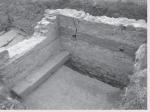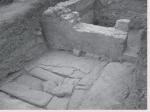Summary (English)
DEULTUM (Hristo Preshlenov – hristo.preshlenov@abv.bg) Exploration of the decumanus continued in the area of its supposed junction with the cardo, discovered during the 1980s to the west of the thermae. Building I preceded the decumanus, which reached the temple of Septimius Severus. The building and the decumanus were dismantled before the end of the 4th century AD, during the construction of Building II, which was burned three times until the beginning of the 6th century AD. During the 6th – beginning of the 7th century AD, Building III took the place of the abandoned street to the east of Building II. Building I was built of roughly cut stones and bricks bonded with mortar. The walls of Building II were 65 – 75 cm wide, built in opus mixtum with ashlars and bands of four courses of bricks. The walls were covered with plaster of two layers with races of brown and green paints. An ashlar with two grooves from the passing of carts with an axle track of c. 1.45 m was reused in the foundation of the wall. Axle track with the same width was documented on the threshold of the eastern gate of Deultum. Building II had an entrance to the east. The decumanus was paved with ashlars, from 1.70 m by 0.60 m to 0.55 m by 0.60 m in size. Traces from fire were documented over the decumanus and the earliest floor of Building II and charcoal, roof-tiles, pottery and four bronze coins minted from AD 383 to 408 were found. The fire was probably caused during a Hunnic attack that occurred after AD 383 and was documented at the eastern and the western gates of Deultum. A fire of the 5th century AD was documented on the later floor of Building II and charcoal, bricks, roof-tiles and pottery were found. A third fire occurred during the beginning of the reign of Anastasius I Dicorus, which was also documented at the eastern gate of Deultum. The finds included roof-tiles, charcoal, pottery and a bronze coin minted in AD 491/498. The walls of Building III were 90 cm wide, built of roughly cut stones bonded with mud.
- Hristo Preshlenov - Archaeological Institute with Museum
Director
Team
Research Body
- Archaeological Institute with Museum






![Download [PDF]](/excavation/skins/fasti/images/results/download_sml.png)
